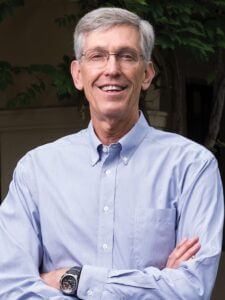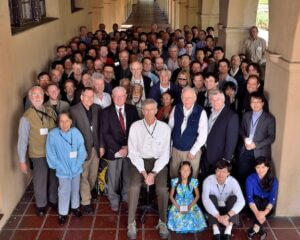
Dr. Harry Jeffrey Kimble (’71), one of the top quantum physicists in the world and a former recipient of Abilene Christian University’s Outstanding Alumnus of the Year award, died Sept. 2, 2024, in Austin, Texas, at age 75.
Kimble was born April 23, 1949, in Floydada, Texas. He earned a bachelor’s in physics from ACU, where he also lettered in basketball. His master’s (1973) and doctoral degrees (1978) were earned at the University of Rochester.
He was a staff scientist for General Motors Research Laboratories (1977-79) and the Sid Richardson Regent’s Chair of Physics at The University of Texas at Austin (1979-89). In 1989 he joined the faculty at California Institute of Technology, where he became the William L. Valentine Professor of Physics and was founding director of the Institute for Quantum Information. He retired in 2021 and moved to Austin.
Kimble was one of three Abilene Christian alumni to be members of the prestigious National Academy of Sciences, along with Dr. Clayton Heathcock (’58) and the late Dr. James Womack (’64).
He received many major awards, including the Einstein Prize for Laser Science (1989), the Julius Edgar Lilienfeld Prize of the American Physical Society (2004), and the Herbert Walther Award of the German Physical Society and the Optical Society of America (2013). Kimble also was the Distinguished Scholar for 2014-16 at the Max Planck Institute of Quantum Optics in Garching bei Munchen, Germany.

In 2014, Caltech held “The Quantum Optics Frontier,” a symposium in Kimble’s honor coinciding with his 65th birthday. International participants traveled to Pasadena, California, to discuss advances in quantum optics which Kimble and his colleagues have pioneered, from the generation of squeezed light, to the realization of quantum measurement beyond the standard quantum limit, to the teleportation of a beam of light.
Dr. Charles Ivey (’65), Kimble’s physics professor at ACU, considered it a thrill to have such an inquisitive and exceptional student as one of his first at Abilene Christian, and recalled a defining moment when Kimble had an insight that impacted him deeply.
“In a Modern Physics class, students get their introduction to the mysteries of quantum mechanics. Jeff was both amazed and motivated by the seeming magic of this aspect of physics, and it seemed to me that he shifted gears into his lifelong pursuit,” said Ivey, who was the first chair of ACU’s physics department.
The discussion topic that day was about “tunneling” through a barrier, a quantum phenomenon in which a ”particle-wave” changes location by “teleportation” through a barrier to a place on the other side. That, Ivey explained, is like going through a wall by simply disappearing on one side and appearing on the other.
“Jeff’s well educated classical background found this just too mystical and impossible to accept. He spoke up, challenging that such a thing could happen,” Ivey said. “I told him it was actually possible but almost infinitely unlikely for him to disappear and reappear from his seat to a position out in the hallway. The probability was not zero that this could happen although the probability was essentially near zero that as many particles as his body contained could all ‘teleport’ outside the classroom as an entangled phenomenon.”

Ivey recalled that Kimble objected strenuously while showing a sense of wonder.
“I then told him he had an assignment to prove the probability of such an event as teleportation was non-zero, no matter the number of states,” Ivey said.
Years later, according to Caltech, “Kimble performed groundbreaking experiments in quantum optics and quantum information science. His achievements include some of the earliest demonstrations of quantum squeezing and quantum teleportation, among many other trailblazing experiments.”
Kimble became known for his pioneering work in cavity quantum electrodynamics – or cavity QED – studying how the interaction between atoms in matter and photons in light can be manipulated by humans.
Caltech said Kimble’s cavity QED experiments “formed the basis of many quantum technologies being developed today. His research also led to experiments that laid the foundations for research into quantum networks – essentially a quantum internet – in which ensembles of atoms are entangled.”
Dr. Larry Isenhower (’05), ACU professor of engineering and physics, and director of physics, said Kimble was one of his inspirations in choosing graduate studies in quantum computing.
“It was reassuring to know I could be successful coming from ACU since he had already done it,” said Isenhower, whose father, Dr. Donald Isenhower (’81), is a longtime Abilene Christian physicist whose faculty colleagues such as Dr. Rusty Towell (’01) and the late Dr. Michael Sadler have led undergraduate students in work on groundbreaking experiments at national labs for years. “I still remember my first opportunity to hear Dr. Kimble speak at a conference and watched for the results coming from his lab. My work was closely related to his, so I often looked to see how their latest developments could be used as inspiration to solve the problems we faced in our own research.”

Kimble donated several pieces of important equipment to his alma mater’s Department of Physics and Engineering.
“I feel a sense of pride and expectation thinking about how the equipment he used to make such great leaps in quantum information science will be used while teaching future ACU scientists, in the hope that they, too, will discover new truths about God’s creation,” Isenhower said.
“There are a lot of really amazing people who have come through ACU and gone on to do great things,” Kimble said after being named his alma mater’s Outstanding Alumnus of the Year award in 2016. “That I was selected, it’s really quite humbling. It’s a great honor. What I’ve done in science, to me it’s not my accomplishment as much as it’s the integrated total of the efforts of the amazing people with whom I have worked.”
He was preceded in death by his parents, John Kimble, O.D., and Joyce Kimble; and a brother, Joel Kimble. Among survivors are Margaret Smith-Kimball, his wife of 45 years; daughters Dr. Katherine Grooms and Megan Kimble; three granddaughters; and brothers Jim Kimble and John Kimble.
— Ron Hadfield
Sept. 10, 2024
